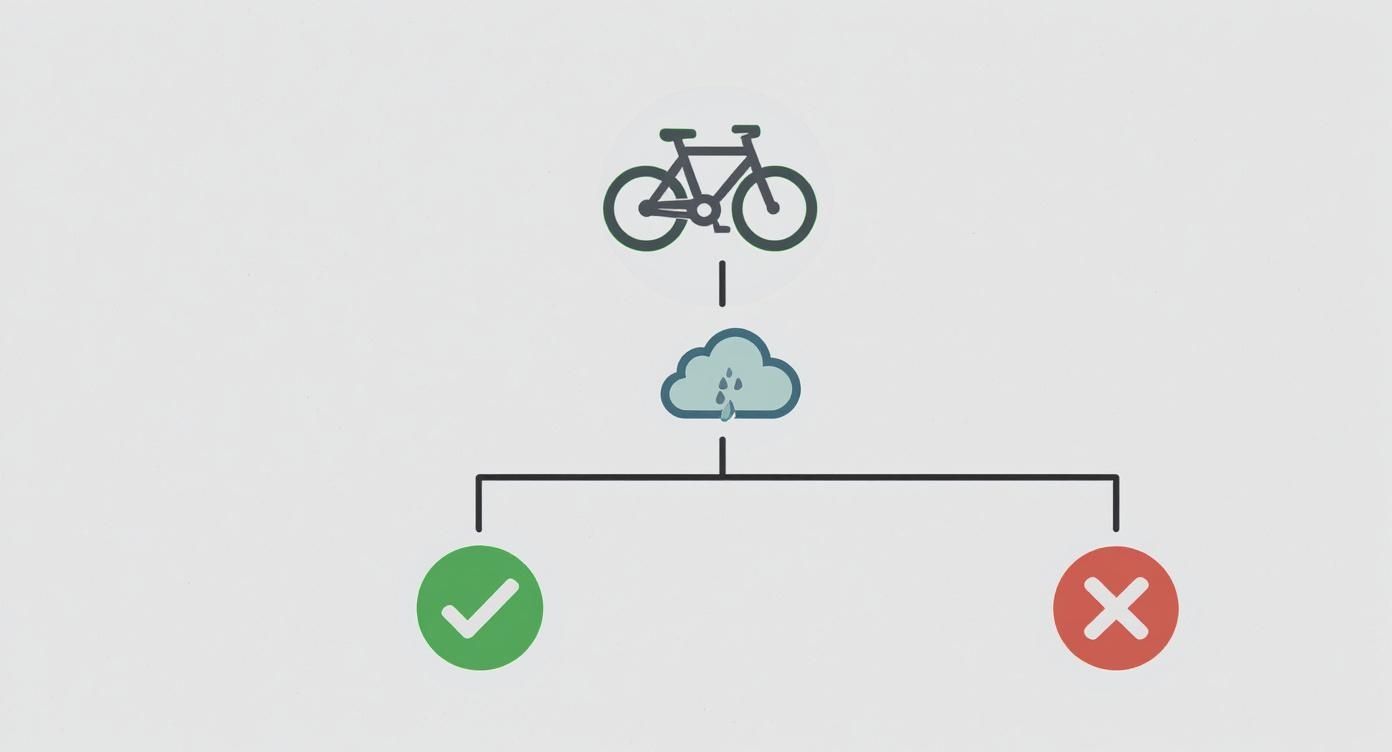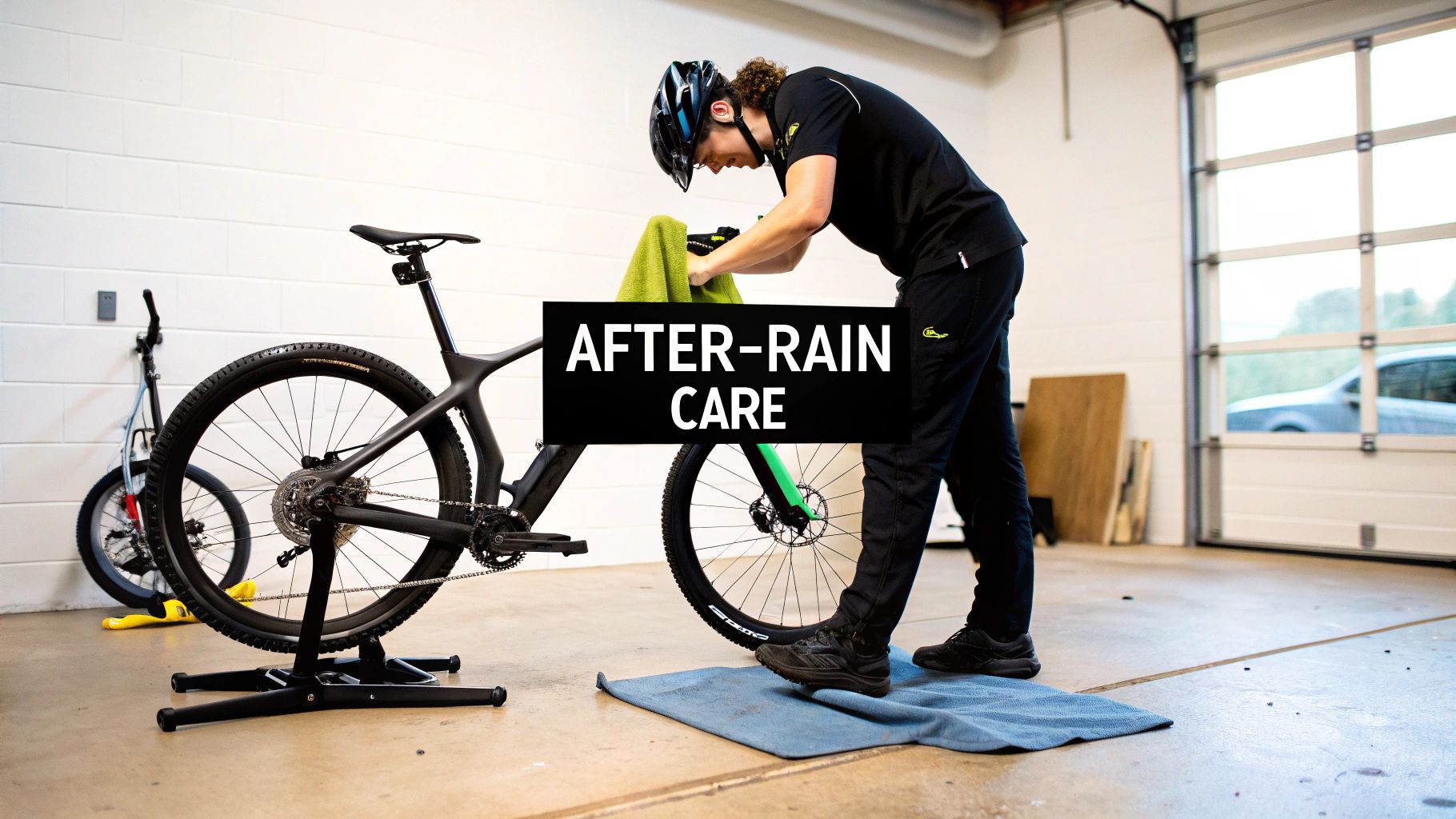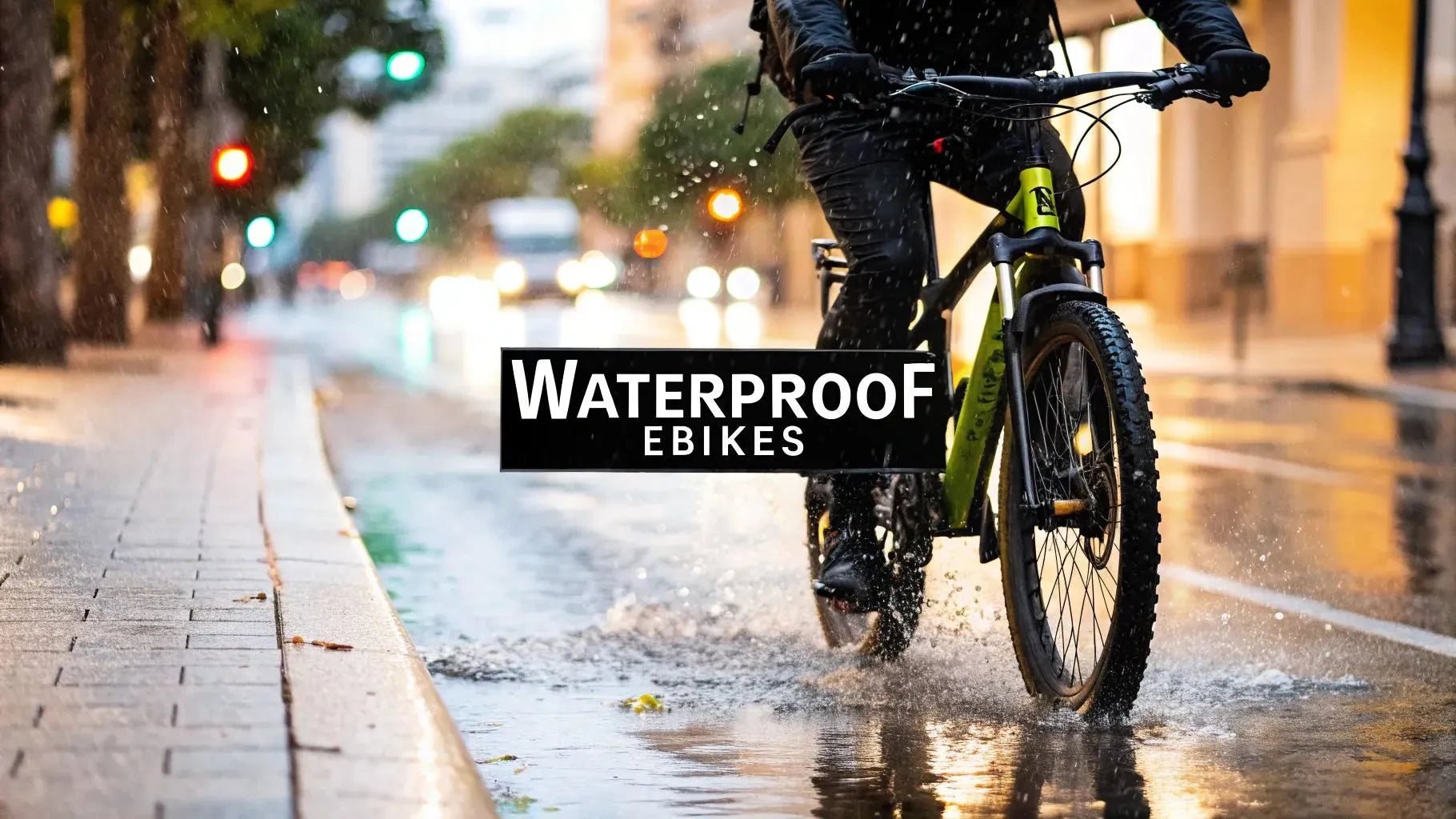Let's cut right to the chase: your ebike is water-resistant, not waterproof. It's a critical distinction.
Think of it like a really good rain jacket. It'll keep you perfectly dry in a storm, but you wouldn't go for a swim in it. The same logic applies to your ebike. You can ride through rain and splash through puddles without a second thought, but never, ever fully submerge it or hit it with a pressure washer.
What Water Resistance Means for Your Ride
Understanding that "water-resistant" label is key to keeping your bike happy, especially if you live somewhere the weather can be unpredictable, whether that's Florida's sudden thunderstorms or a drizzly day in the Pacific Northwest. Most modern ebikes are built tough enough for the real world, which definitely includes surprise rain showers and slick roads.
How do they do it? Manufacturers focus on sealing up the most important electrical parts—the battery, motor, and controller. These core components often come with an official Ingress Protection (IP) rating, like IP65 or IP67, which is basically a fancy way of saying they're certified to stand up to water jets or even a quick dunk.
For you, this translates to peace of mind on most wet rides. But it's not an excuse to get reckless. Your ebike's defense system relies on seals and gaskets that can wear out over time. It’s like your phone—it can handle getting splashed, but you're not taking it into the hot tub. A little bit of care goes a long way. If you want to gear up properly, check out our guide on the best electric bike accessories.
Navigating Wet Conditions Safely
So what does this all look like in the real world? It really comes down to using a bit of common sense.
Here’s a quick rundown:
- Rainy Commutes: Riding in light to moderate rain? Totally fine. Your ebike's sensitive parts are shielded for exactly this kind of thing.
- Puddle Splashing: Hitting a few puddles on the road won’t cause any problems. The seals are designed to keep that kind of splash out.
- Washing Your Bike: Stick to a gentle rinse with a low-pressure hose or just wipe it down with a damp cloth. Never use a power washer—it can force water past even the toughest seals.
Knowing these basics helps you sidestep expensive, easily avoidable mistakes. It's no wonder ebikes are getting so popular; the global ebike market growth on Statista.com shows they're becoming a go-to for reliable transport.
Here's a simple table to help you remember what's safe and what's not.
Quick Guide to Ebike Water Resistance Levels
This little cheat sheet breaks down what you can and can't do with your ebike in different wet scenarios.
| Activity | Is It Safe for My Ebike? | Why or Why Not |
|---|---|---|
| Riding in light rain | Yes | Components are sealed to handle rain and road spray. |
| Riding in a heavy downpour | Yes, with caution | Most ebikes are fine, but prolonged exposure isn't ideal. |
| Splashing through puddles | Yes | The seals are designed to prevent this kind of water entry. |
| Hosing it down gently | Yes | A low-pressure rinse is a safe way to clean your bike. |
| Using a pressure washer | No | The high pressure can force water past seals and into electronics. |
| Leaving it in the rain | No | Prolonged, direct exposure can wear down seals over time. |
| Submerging the bike | Absolutely not | This will almost certainly cause catastrophic damage. |
Keep this guide in mind, and you'll keep your ebike running smoothly for years, rain or shine.
Understanding Your Ebike's IP Rating
Ever glanced at your ebike’s specs and seen a code like IP65 or IPX4? It looks a bit technical, but this Ingress Protection (IP) rating is your single best clue for figuring out how well your ebike can handle a bit of wet weather. It’s a standardized system used worldwide, from Australia to the US, giving you a clear, no-nonsense idea of how sealed up the electrical bits are.
Think of it as a two-digit report card for your bike's electronics. The code always starts with "IP," followed by two crucial numbers.
Cracking the Code: What the Two Numbers Mean
The first number is all about protection from solids—dust, dirt, and grime. It’s rated on a scale from 0 (zero protection) to 6 (completely dust-tight). That’s great for keeping gunk out of your motor, but when you’re wondering if your ebike is waterproof, the second number is the one to watch.
This second digit tells you everything you need to know about liquid protection. It runs from 0 (again, nothing) all the way up to 8 (can handle being completely submerged in water). For any ebike rider, a higher second number means more peace of mind when the sky turns grey.
This visual guide breaks down what’s safe and what’s definitely not.

As you can see, ebikes are built to be water-resistant for riding in the rain, but they're absolutely not designed to go for a swim.
What IP Ratings Mean for Your Ride in the US and Australia
So, how does this translate to a drizzly commute in Sydney or a surprise shower in Seattle? Let's get practical. An ebike with a display rated at IPX4 can take splashes from any direction. That means you're totally fine riding through puddles or getting caught in light rain. It's a solid baseline for most everyday ebikes.
Now, a more rugged ebike might boast an IPX6 rating for its motor or battery. This is a big step up—it means the component can handle powerful jets of water. While you should still never take a pressure washer to your bike, that higher rating gives you serious confidence when you’re caught in a proper downpour. That jump from a 4 to a 6 makes a real-world difference.
Here's the key takeaway: IP ratings are usually for specific components—the motor, the battery, the display—not the whole bike. You’ll often find a motor with a tough IP66 rating, while the handlebar display might be a more modest IP64.
This is why you have to dig into the specs for each part. At the end of the day, your bike is only as water-resistant as its weakest link. Knowing these individual ratings helps you understand your ebike's real limits, avoid expensive mistakes, and ride smarter, no matter what the weather decides to do.
Protecting Your Ebike's Most Vulnerable Parts
When it comes to fending off a downpour, not all parts of your ebike are created equal. To really get a handle on whether an ebike is waterproof, you have to break it down and look at the individual bits and pieces that make it go. Think of your ebike's electrical system like a knight's suit of armour—some parts are heavily plated, while others have potential weak spots.

The heart and soul of your ebike—the battery, motor, and controller—are where the real protective muscle is. Manufacturers typically tuck these core components away in sealed casings made from tough aluminum or durable plastics, often using rubber gaskets to slam the door on moisture. This is why these parts usually boast higher IP ratings and can laugh off rain and road spray.
The Strongest Links in the Chain
Your battery and motor are the heavyweights in the fight against water. The battery case, for instance, is built like a fortress to shield the delicate lithium-ion cells inside. Likewise, both hub motors and mid-drive systems are engineered as self-contained, sealed units to stop water from getting anywhere near their complex internal windings and sensors.
This robust protection has become a huge selling point, especially in places where people ride their ebikes all year. In US states with varied climates like Colorado or across Australia, where a ride can start in the sun and end in a downpour, riders demand reliability. This pressure has pushed brands to invest in high-quality, water-resistant batteries, sealed connectors, and corrosion-resistant materials to keep things humming along smoothly, no matter the weather.
Pinpointing the Potential Weak Spots
Even with a tough core, your ebike has a few areas that need a little extra TLC. These are the spots where water is most likely to sneak in if you’re not paying attention.
- Charging Ports: This is a direct line to your battery. Always, always make sure the little rubber or plastic cover is snapped on tight before heading out in the wet.
- Cable Entry Points: Any spot where a wire enters the frame or a component is a potential chink in the armour. They’re usually sealed, but those seals can wear out over time.
- Display Screens: The seams around your handlebar display can be a bit fragile. While they're sealed against splashes, they aren't designed to withstand a pressure washer or a non-stop deluge.
- Connectors: The points where cables plug into the motor, battery, and controller are sealed, but they can be compromised if they get gunked up with dirt or damaged.
A tiny crack in a seal or a forgotten port cover can be all it takes for water to get in. Regular checks of these areas are a quick and easy way to prevent expensive problems down the line.
Knowing where your ebike is solid and where it’s a bit vulnerable lets you ride with confidence. A quick pre-ride inspection on a wet day can make all the difference, just like checking your tire pressure is key to a safe trip. In fact, knowing how to handle basic upkeep is a must for any rider, and you might find our guide on ebike tire repair helpful for other common jobs. By understanding this balance of strength and vulnerability, you can protect your investment and keep rolling, whatever the weather throws at you.
Best Practices for Riding Your Ebike in the Rain
The sky opens up midway through your commute—now what? Don’t panic. We all know ebikes aren't submarines, but a bit of rain doesn't have to ruin your ride. With a few smart moves and quick checks, you can navigate those wet streets like a pro.
Before you even roll out the door, take thirty seconds for a pre-flight check. The single most important thing to look at is your battery charging port. Make absolutely sure that little rubber or plastic cover is pushed in tight and fully sealed. It’s a direct line to your bike's electrical heart, and leaving it open is just asking for problems.
Next up, give your battery a little shake. Does it feel solid in its mount? A loose battery can create a gap where water can sneak into the electrical contacts, which is a fast track to all sorts of gremlins. You want that thing locked in place, nice and snug.
On-the-Road Adjustments for Wet Conditions
Once you're riding, you’ve got to change how you handle the bike. Wet pavement and the instant torque from an electric motor can be a sketchy combination, but a few simple tweaks make all the difference.
One of the smartest things you can do is lower your pedal-assist level. Kicking it into "Turbo" on a wet road, especially when pulling away from a stop, is a recipe for spinning out your back wheel. Dropping it to a lower, gentler setting gives you far better traction and control. Think of it like easing onto the gas pedal in a car on an icy day.
Also, be super paranoid about puddles. You have no idea what’s hiding under the surface. That innocent-looking puddle could easily be concealing a wheel-wrecking pothole.
What’s even worse? A deep puddle could dunk your motor or battery housing. Even with high IP ratings, those parts are built to resist spray, not a full-on submersion. Going around deep water is always the right call.
Essential Gear for All-Weather Riders
Having the right equipment transforms a wet ride from miserable to manageable. A small investment in the right gear seriously boosts your safety and comfort, making a rainy day just another day on the bike.
Here are a few pieces of kit I consider non-negotiable for riding in the rain:
- Full-Length Fenders: Seriously, don't leave home without them in the wet. They keep a firehose of water, mud, and road gunk from spraying all over you and your bike’s sensitive electrical components.
- Good Lights: Visibility plummets when it's raining. A bright set of front and rear lights is absolutely critical so you can see where you're going and, more importantly, so drivers can see you.
- Waterproof Outerwear: A quality waterproof jacket and a pair of rain pants make all the difference. They keep you dry, which lets you focus on riding safely instead of thinking about how cold and soaked you are.
Combine these quick checks, riding adjustments, and essential gear, and you’ll be ready to handle pretty much anything the weather decides to throw at you.
Post-Ride Care to Prevent Water Damage
So, you've made it home after a wet ride. Great! But the job isn't done just yet. What you do next is just as crucial as dodging puddles out on the trail. This is your best defense against the slow, sneaky damage that moisture loves to inflict, like corrosion and electrical gremlins.

Think of it like a cool-down routine for your bike. It’s a simple process, but it’s the key to preventing long-term problems and getting the most life out of your ebike. Skipping this step is like putting away a wet tent—you're just asking for trouble later on.
First things first: grab a dry, clean cloth and give the whole bike a good wipe-down. Make sure you hit the battery casing, the motor housing, and the display screen. This isn't just about appearances; it's about removing surface water before it has a chance to seep into any nooks and crannies.
Your Post-Ride Checklist
Once the initial wipe-down is done, it's time for a little more detail. If you can make this routine second nature after every rainy ride, you’ll save yourself a ton of expensive headaches down the road. It only takes a few minutes.
Here’s a simple but effective process to lock in:
- Dry Key Electrical Contacts: If you can safely get to them, unplug connectors like the one for your display and gently dry both ends. Pay extra close attention to the battery terminals and the charging port. You want them completely moisture-free.
- Lubricate Your Chain: Water and your drivetrain are not friends. After wiping the chain dry, apply a quality chain lube. This doesn't just keep it running smooth; it pushes out any trapped moisture and puts up a protective barrier against rust.
- Store It Smartly: If you can, bring your bike inside to a dry, well-ventilated spot like a garage or shed. This lets any hidden moisture evaporate on its own. It's best to avoid throwing a cover on it right away, as that can trap humidity against the bike’s components.
Critical Battery Care After a Wet Ride
Your ebike's battery demands some extra TLC after a rainy ride. This is one spot where you absolutely cannot cut corners.
The golden rule of wet ebike care is this: NEVER, ever charge a wet battery. Plugging it in while there's any moisture around the charging port or terminals is a huge risk. It can cause a short circuit, permanently fry the battery, or even create a fire hazard.
Always, and I mean always, make sure the battery and its port are bone-dry before you even think about plugging in the charger. If you have the slightest doubt, just wait. A little patience goes a long way in preserving your electric bike battery life. Taking these simple steps ensures your ebike is ready and, more importantly, safe for your next adventure.
Even after getting the hang of IP ratings, a few questions always seem to come up. Let’s tackle the big ones head-on so you can ride with confidence, no matter what the clouds are doing.
Can I Use a Pressure Washer to Clean My Ebike?
Short answer: No. Please, don't do it.
Using a pressure washer is one of the fastest ways to wreck your ebike's electronics. Think of it this way: your bike’s seals are built to keep out rain, which falls from the sky. They aren't designed to fight back against a concentrated, high-powered jet of water.
That intense blast can easily push water past protective gaskets and straight into your motor, battery case, or controller. Even a high rating like IP67 won't stand a chance against that kind of force. You're just asking for short circuits, corrosion, and a very expensive repair bill. Stick to a low-pressure garden hose or the classic bucket and sponge.
What Should I Do If My Ebike Gets Completely Submerged?
Okay, let's say the worst happens and your bike goes for an accidental swim. The absolute first rule is: do not turn it on. Firing up the electrical system while it's wet could cause a massive short circuit and instantly fry the electronics.
Here’s your game plan:
- Kill the Power: Get that battery off the bike immediately, if you can. This cuts the main power source.
- Drain It Out: Tip the bike every which way—even upside down—to let any trapped water escape from the frame and motor housing.
- Dry Everything: Grab a soft cloth and dry every surface you can reach. Give extra attention to all the connectors and terminals.
- Call a Pro: Before you even consider riding it, take it to a qualified ebike mechanic. They have the tools to open things up and make sure it’s completely dry and safe to use.
Are Some Ebike Models More Waterproof Than Others?
Absolutely. There's a huge difference between models. An ebike built for hardcore trail riding, like an electric mountain bike (eMTB), is going to have much better weather sealing and higher IP ratings. These bikes are engineered from day one to handle mud, puddles, and stream crossings.
On the other hand, many city or commuter ebikes are designed to handle rain and a bit of road spray, but not much more. They’re plenty capable for their intended use, but they don't have the same fortress-like protection. When you’re shopping, really look at the specs for the motor, battery, and display. Brands that put in the effort to properly seal their bikes are usually happy to brag about the IP ratings.
Most manufacturer warranties cover defects in workmanship, which might include a faulty seal failing under normal rainy conditions. However, nearly all warranties explicitly exclude damage from misuse, such as pressure washing, deep water submersion, or leaving the bike out in a storm.
Will My Ebike Warranty Cover Water Damage?
This is the million-dollar question, and the answer is a classic "it depends." Your warranty is there to cover manufacturing screw-ups. So, if a seal was installed wrong at the factory and fails during a normal ride in the rain, that should be covered.
But—and this is a big but—warranties almost never cover damage from rider error. Taking your bike for a swim, blasting it with a power washer, or leaving the charging port open in a downpour is considered misuse. Any damage from that is on you. Always read the fine print of your warranty. The best way to stay protected is just to follow the manufacturer's care instructions.
At Punk Ride LLC, we believe the right gear makes every ride better, rain or shine. Our handpicked selection of ebikes and accessories from awesome brands like ENGWE, CYSUM, and DUOTTS are built for real-world riding, so you can roll out with confidence every day. Find your perfect all-weather ride at https://www.punkride.com.





Share:
Your Guide to Electric Bicycle for Delivery Success
e scooter vs ebike: The Ultimate Commuter Showdown